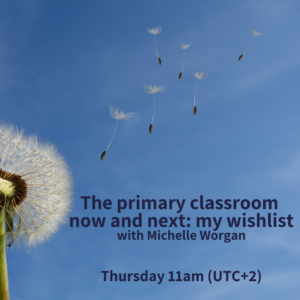It was fabulous to have Michelle Worgan joining us for this week’s webinar as it gave us lots to reflect on about not only the primary classroom, but other ways in which ELT might develop in the future. Michelle has a particular interest in primary education and is involved in ELT publishing at this level, having written materials for Pearson’s new Rise and Shine course and Global Stage from Macmillan.
Michelle started out by talking about how we can use the recent period of upheaval as an opportunity to make lasting changes to improve language learning in the primary classroom. She shared a padlet and encouraged us to reflect on her initial ideas and add any of our own wishes for the future of primary ELT.
Back to Basics
Michelle talked about the importance of community and connection and how we noticed much more the relationships we have with different people during lockdown. Although in some countries students are now back in the physical classroom, in other places there are still restrictions in place and Michelle suggests that students will need support on their return to the face-to-face environment. She suggests as well that there should be more collaborative work for students to be able to use language to really communicate, and a move away from heads-down, individual work.

Real world learning
Language isn’t just another subject to study, it’s something which allows us to be a part of the world around us and to communicate with others. We should be moving away from a grammar-based syllabus to a more responsive syllabus which teaches the students the language they really need. Michelle referred back to Elizabeth Coleman’s webinar on Transformative Pedagogy and the importance of seeing our students as real, whole people.
Grass- roots learning
Michelle would like to see a more localised, context-driven approach, rather than a global, ‘one size fits all’ approach. She talks here about both the materials we use as well as the approaches that we use in the classroom. As teachers, we know – or can ask our students – what content is relevant in our classes.
She went on to talk about enquiry-based learning, providing an example of how this could work with a unit on clothes and allow students more choice in their learning and presenting their work.
An inclusive classroom
Michelle shared some facts, taken from UK research, which showed the percentage of students with specific learning differences, including dyslexia and AD(H)D. She highlighted that language learning may favour some students over others, particularly in the communicative approach, and that students might feel they have less chance of success in English if we don’t cater to this group in our classes. An enquiry-based approach might be more effective in an inclusive classroom as it allows for learners to take more responsibility for how they learn.
Play
We know that young children learn socio-emotive skills, behaviour management and more through play and Michelle believes children should be able to play as freely as possible in the classroom. There are also opportunities to use costumes, manipulatives (such as Play Doh or Lego) and imaginative role play with older primary students and even in secondary and adult education.
Democracy and autonomy
As adults, it’s easy for us to forget that children are people with important ideas and we feel we can make decisions for them as we have more experience of the world. In the ELT classroom, which is perhaps less high-stakes than the mainstream classroom, we can allow them more choices – for more on Learner Choice, check out Claire Thomson’s webinar.
Assessment
Michelle would like to see more formative, personalised assessments rather than summative assessment. She talked a little about the culture around testing and numerical grades, but highlighted that traditional tests can be difficult for students who struggle under pressure or have trouble concentrating. She suggested alternatives such as exit tickets, portfolios and posters. Personalised benchmarks are also a great motivator for students both in terms of supporting those that need it and pushing others to do more.
A local approach
It would be good to see more flexibility in materials design, with alternative versions of materials in coursebooks to ensure more inclusive and diverse content. This would enable local authorities to tailor the course to their contexts, without restricting materials for others which might be viable in different cultural contexts.
For more on this, take a look at Brian Tomlinson’s article Connecting the Course Book from TESOL.
A happy classroom
This was originally two separate ideas: a place where the students want to be and a place where the teacher wants to be. However, the two are intertwined. Creating a warm, supportive environment where everyone wants to be is what we want, as younger learner teachers especially.
References
- Enquiry-based learning: Chapter from Teaching and Learning in International Schools: Lessons from Primary Practice, Critical Publishing, ed. Anssi Roiha, Eryn Wiseman
- Project-based learning: The Routledge Handbook of Teaching English to Young Learners – Chapter 18: Language learning through projects; Arnold, Coralyn Bradshaw, Kate Gregson
- Play-based learning: Developing life skills through play, CUP, 2019
- Play-based learning in primary school (Non-ELT book), M. Briggs, A. Hansen
- Affective teaching: Understanding social and emotional intelligence among English language teachers
- Inclusion: http://eltwell.com/resources/inclusive-language-teaching/
- Formative assessment: Getting started with assessment for learning
